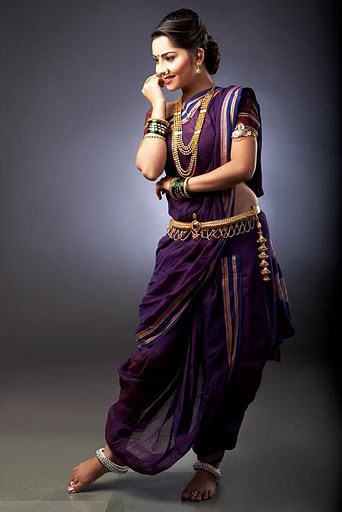It is true that it is an absolute horror to drape six-yards of cloth alone. It is almost impossible to understand which part of the cloth goes where! But, it is also true that when those torturous hours of understanding the art of draping are over, the saree clings to our body like it was made for it!
The six yards of clothing spells grace and elegance. Right from everyday life to farewell parties to Bollywood, saree shines everywhere!
History of Saree
Saree is considered to be the oldest form or clothing which is still in existence. The earliest known evidence of saree is the discovery of an idol from the Indus Valley era wearing a drape, which dates back to 2800-1800 B.C. Ancient Tamil poetry reveals that the navel was considered to be the source of life and innovation; hence the midriff was left bare. Saree originated from dhotis that were worn by men and women both.
The only differenced was that women often accompanied this dhoti with a breast band or another piece of clothing that covered their chest. However, there is also evidence that shows that during the Sangam period in ancient South-India, women did not opt for any such clothing that covered the upper body; they only draped the dhoti.
It is also possible that saree p popularized because of the Hindu belief that stitching a cloth makes it impious. Lehengas and ghaghras are also said to have evolved from saree.
Different Types of Sarees of Different States
The basic requirements for draping a saree are- saree (no surprises there), petticoat, blouse. So Lets get started!
#1. North Indian Style Saree
The most common style of draping is the North Indian style. In this, the saree must be wrapped around the waist, pleated and attached to the petticoat. After this should be another half circle and then the free end goes over the shoulder to make a pallu. This style is common in Haryana, Uttar Pradesh, Bihar and parts of Punjab. As a mark of respect to elders, some women take the pallu over their head.
#2. Nivi Drape Saree
Nivi drape is typical in areas of Tamil Nadu. This kind of draping allows the wearer to move her legs freely while entirely covering them. Here, the pleats are passed between the legs and tucked into the waist at the back.
#3. Maharashtrian Style Saree

For draping a saree in Maharashtrian style, tuck the pleat towards the left side of the waist. The two ends of the cloth are tied together and wrapped around the legs. Pallu must be brought to the front from the back and pleated into around 4-inches. Tuck these pleats at the navel.
#4. Gujarati Style Saree
To wear a saree in Gujarati style, start by draping the saree from the right side and tuck it in fully at the back towards the left. Bring the remaining fabric forward and pleat it. The pallu must flow from back to the front. Secure the pallu at the waist with pins.
#5. South Indian Style Saree
South Indian style of wearing a saree is much easier than it looks. Take around 1 meter of the fabric and drape it around your frame and tie a knot at your waist. Take a shorter length of the material and make pleats. Carry it between the legs and tuck one edge at the back.
Take the remaining width to the left and tuck the last edge at the front. The fabric left in the front must be taken between the legs to the back and tucked in. Take the pallu over the left shoulder and drape it the front from right, and tuck it at the waist.
Top 8 Types Of Sarees Available In India
Here are the list of top 8 famous sarees in India. Let’s Check it out!
1. Benarsi Saree
Handwoven in Varanasi, Uttar Pradesh, these sarees are made of silk fabric and come in vibrant colors. They are famous for their gold and silver brocades and embroidery. They showcase intricate designs and motifs. It was originally worn by royalty and was made with real silver and gold threads.
2. Bandhani Saree
Made from tie and dye technique, it gets its name from the Hindi word “Bandhan,” which roughly translates to ties. They were initially made in chiffon but have now shifted to cotton and other fabrics as well. They are fit for summer wear because of their flowy fabric. The traditional art of tying the cloth and dying it in various colors to get a dotted pattern in used for creating these sarees.
3. Kalamkari Saree
Artists use special pens made out of bamboo for designing these sarees. Once the fabric is ready, it is dipped in a solution of milk and natural dyes after which the designing is done. Mostly naturally occurring vegetable dyes are used for these sarees. It is mainly produced in Andhra Pradesh. Mythology and ancient sculptures inspire the designs on these handprinted sarees.
4. Chanderi Saree
These were known for their pastel hues. However, with the changing time, vibrantly colored Chanderi sarees are also being made. These cotton and silk sarees are decorated by motif and butis. The border usually has a very intricate design, and the outline of the border is done with a different colored thread. Traditionally Chanderi sarees were made out of cotton with heavy gold work or embroidery at the border. Now, chanderi cotton, pure silk, and cotton silk fabrics have become popular.
5. Kanchipuram Silk Saree
Made by craftsmen of Kanchi, a small village south of Bangalore, Kanchipuram sarees are demanded worldwide. The pallu and the body of the saree are in contrasting colors and filled with detailed designs. These designs are inspired by temples, idols, and scriptures. It may comprise of flowery butas, checks or stripes. It started as a nine-yard saree, but over the years it has been reduced down to six-yards with copper or metal zari embroidery.
6. Taant Saree
It is a traditional variant of saree mainly worn by Bengali women. They are manufactures in Hooghly and parts of Bangladesh. They have a thick border, and the pallu is decorated with motifs. These are made of cotton fabric and are somewhat transparent. They are light weighted and perfect to be worn in summers.
7. Pochampalli Saree
This type of silk is found in Boodhan Pochampalli area of Nalgonda district in Andhra Pradesh. It is known as the ‘Silk City’ of India. The distinguishing feature of these sarees is their Ikkat prints- which is a tie and dye technique that works around preventing color from spreading unevenly onto the fabric. Most of these designs are abstract.
8. Muga Silk Saree
These sarees are made of Muga silk which is produced by the Garo community in Assam. A golden yellow base is common to these sarees. However, more colors are added using embroidery and zari work. The motifs are geometrical in shape, and the heavy zari work gives a feeling of royalty.
To Conclude
The dress sense of people in India has undergone a drastic change over the years. But through it all, the magic of saree has remained the same. To add to that, saree has gained much popularity even in the West, and the demand for Indian handwoven sarees has grown exponentially in the West. Now that you know all about sarees, we hope you will consider it at every outing!
Also Read: History of Kumbakonam Degree Coffee










Great info about different sarees.
To know how to style these sarees in a unique way.
Hi,This article is so useful for me about different parenting styles.
good job and thank you!!!
Hi,This article is so useful for me about different parenting styles
good job and thank you!!!
certainly like your site and you really need to confirm the punctuational with some of your content regularly.. saree style Many of them are usually rife together with punctuation problems and I believe that it is extremely irritating to see reality however I’m going to definitely appear once again once more.